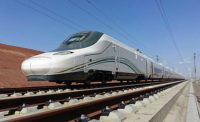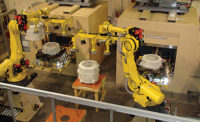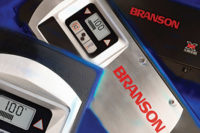Many automotive engineers have nightmares about noise, vibration and harshness (NVH) issues. Ironically, one of those pests—vibration—is widely used to assemble many types of plastic auto parts.
Vibration welding, a cousin of ultrasonic welding, is a popular assembly process because it has many advantages. It can join similar and dissimilar thermoplastics. Vibration welding can also assemble parts produced in different ways, such as blow molding, injection molding or 3D printing.
In addition, vibration welding can weld large parts with complex shapes. It is a relatively fast process for joining large plastic parts. And, because it applies pressure before heat, some amount of part warp can be accommodated.
Vibration welders can join virtually all thermoplastics, including many types of nylons, polyamides, polycarbonates and polypropylenes. The 50-year-old joining process also tolerates additives, colorants, fillers and contaminants.
Most vibration welders today use electric servos and linear electromagnetic drive systems. Servo actuation reduces maintenance, increases uptime and uses more than 30 percent less energy than hydraulic machines.
“Linear vibration welding physically moves one of two parts horizontally under pressure, creating heat through surface friction that melts and welds the parts together,” says Phil Sandow, vice president of sales and marketing at Telsonic Ultrasonics Inc., which offers a full line of high- and low-frequency vibration welders.
“Compared to ultrasonic welding, vibration welding operates at much lower frequencies, higher amplitudes and much greater clamping force, creating large sealed weld areas,” explains Sandow. “Electromagnetic heads eliminate wear and lubrication associated with bearing surfaces. Electric servos enable us to control pressure and achieve tighter tolerances during the melt down.”
Popular Plastic Process
Vibration welding is a well-established assembly process that is applicable to a wide range of part geometries and materials, making it ideal for producing parts that are used in everything from automobiles to washing machines.
“One of the main advantages of vibration welding is that it can be used for very large parts,” says Miranda Marcus, senior engineer for polymer joining at EWI. “Parts up to six feet long can be joined. By comparison, ultrasonic welding is typically limited to about a 12-inch-square [cube size], and even then will not provide a continuous weld.
“The only real limitation to the size of the parts that can be welded is the cost-effectiveness of building larger machines,” explains Marcus. “Five to six feet is the limit for currently manufactured equipment. Right now, there isn’t any financial incentive to building larger, because there are very few plastic assemblies larger than two-by-five feet that would benefit from vibration welding.
“While many other processes can weld large parts, such as hot-plate, laser and infrared welding, vibration welding is typically much faster,” Marcus points out. “On the negative side, it does tend to produce particulate (plastic dust), which is not acceptable for some applications. Additionally, vibration welding requires a more planar surface than hot-plate, laser and infrared welding do.”
Vibration welding has an average weld time of 10 to 15 seconds and a hold time of around 15 seconds. According to Marcus, assembly processes that can weld parts of the same approximate size, such as hot plate and infrared, have an overall cycle time of 45 seconds and up. Laser welding can be as fast as vibration welding, but at a significantly higher cost for larger parts.
“Vibration welding works best with materials that are fairly rigid and which have a high coefficient of surface friction,” says Marcus. “Examples include acrylonitrile butadiene styrene, polyamide, polycarbonate and polybutadiene terephthalate. Polypropylene can be vibration welded well if the parts have thick walls, or if some glass fill is added.
“Polytetrafluoroethylene (Teflon) does not work well with vibration welding, due to its low coefficient of friction,” warns Marcus. “Alternatively, while thermoplastic urethane has a high coefficient of friction, it is too soft to be vibration welded.
“Vibration welding is often better at achieving joints between dissimilar parts than other processes,” explains Marcus. “That may be due to the increased mechanical disruption of the melt during the process, due to the high amplitude vibrations across the weld plane. However, in general, semicrystalline plastics will not bond to dissimilar semicrystalline plastics.
“Typically, a butt-style joint is used for vibration welding,” says Marcus. “It is important that there be enough land area in the joint and clearance to accommodate the vibration that will occur during welding.
“If the joint width is narrower than the amplitude of the vibration, then the parts may lose contact [at some point during] the weld, which leads to opportunities for deformation or damage,” adds Marcus. “If appearance is a concern, a flash trap can be added to hide the melt that will be extruded during welding.”
Evolving Applications
While vibration welding is used to assemble a variety of plastic products in many industries, it has traditionally been associated with automotive applications.
“The process is used by OEMs and Tier One suppliers to mass-produce air bag chutes and frames, headlights, taillights, instrument clusters and instrument panels,” says Priyank Kishor, global product manager for non ultrasonics at Emerson Automation Solutions. “Many types of under-the-hood parts are also assembled with vibration welding, including filters, fluid tanks and manifolds.”
In particular, air intake manifolds, carbon canisters and resonators have driven demand for vibration welders for decades. In fact, vibration welding was actually developed in the early 1970s to mass-produce carbon canisters to meet new emission requirements.
Today, some large automotive suppliers, such Mann+Hummel and Marelli, use thousands of vibration welders to mass-produce parts that support internal combustion engine (ICE) power trains.
But, as the auto industry continues to evolve toward electric drivetrains, traditional production volumes for manifolds and other ICE parts will decline over the next two decades. Not surprisingly, many manufacturers that have relied heavily on vibration welding in the past are now shifting their attention to e-mobility technology such as batteries and fuel cells.
“Although traditional market growth has become stagnant, we still sell a lot of vibration welders and tooling,” says Ray Laflamme, worldwide automotive marketing manager at Dukane Corp. “And, electric vehicles provide several new applications for vibration welding.
“Battery enclosures represent an emerging market,” notes Laflamme. “Cooling ducts are another application. Just like air-intake manifolds on an ICE, electric vehicles need to be cooled. Vibration welding is ideal for the same reasons: It’s an effective way to mass-produce large parts that must be hermetically sealed. And, most applications use semicrystalline materials.
“Many instrument panels are now assembled with low-frequency vibration welders, and this trend should continue with electric vehicles,” explains Laflamme. “In fact, because of lightweighting efforts, we expect to see fewer metal parts in future instrument panels. Automotive engineers want to use more plastic structures to handle crash and impact requirements.
“There is also a trend in the auto industry toward using bigger plastic parts, due to lightweighting efforts,” says Laflamme. “As less metal is used in the future, vibration welding may become popular for assembling body panels and other structural parts.”
Beyond automotive applications, appliance manufacturers continue to invest in vibration welding technology to assemble everything from plastic dishwasher spray arms to washing machine tubs.
“We’re starting to see more applications that involve see-through doors,” explains Laflamme. “If engineers can’t assemble them with fasteners and gaskets, then they turn to vibration welding to obtain a hermetic seal.
“We also see some interesting applications in the medical device industry, such as catheters, filters and containers that collect bodily fluids,” adds Laflamme. “Another emerging market is in the packaging industry. Because some new types of reusable plastic containers and skids are large, they are produced with vibration welding technology.”






